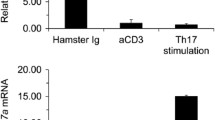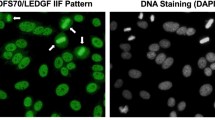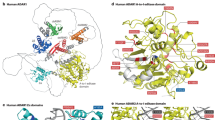Abstract
An RNA-binding protein, the Ro 60 kDa autoantigen, is a major target of the immune response in patients suffering from two systemic rheumatic diseases, systemic lupus erythematosus and Sjogren’s syndrome. In lupus patients, anti-Ro antibodies are associated with photosensitive skin lesions and with neonatal lupus, a syndrome in which mothers with anti-Ro antibodies give birth to children with photosensitive skin lesions and a cardiac conduction defect, third degree heart block. In vertebrate cells, the Ro protein binds small RNAs of unknown function known as Y RNAs. Although the cellular function of Ro has long been mysterious, recent studies have implicated Ro in two distinct processes: small RNA quality control and the enhancement of cell survival following exposure to ultraviolet irradiation. Most interestingly, mice lacking the Ro protein develop an autoimmune syndrome that shares some features with systemic lupus erythematosus in patients, suggesting that the normal function of Ro may be important for the prevention of this autoimmune disease. In this review, we summarize recent progress towards understanding the role of the Ro 60 kDa protein and discuss whether the cellular function of Ro could be related to certain manifestations of lupus in patients.


Similar content being viewed by others
Abbreviations
- RNP :
-
Ribonucleoprotein
- RRM :
-
RNA recognition motif
- SCLE :
-
Subacute cutaneous lupus erythematosus
- SLE :
-
Systemic lupus erythematosus
- snRNP :
-
Small nuclear ribonucleoprotein
- SS :
-
Sjogren’s syndrome
- UV :
-
Ultraviolet
- VWFA :
-
von Willebrand factor A
References
von Muhlen CA, Tan EM (1995) Autoantibodies in the diagnosis of systemic rheumatic diseases. Semin Arthritis Rheum 24:323–358
Provost TT, Watson R, Simmons-O’Brien E (1996) Significance of the anti-Ro (SS-A) antibody in evaluation of patients with cutaneous manifestations of a connective tissue disease. J Am Acad Dermatol 35:147–169
Patel P, Werth V (2002) Cutaneous lupus erythematosus: a review. Dermatol Clin 20:373–385
Lee LA (2001) Neonatal lupus: clinical features, therapy, and pathogenesis. Curr Rheumatol Rep 3:391–395
Lerner MR, Boyle JA, Hardin JA, Steitz JA (1981) Two novel classes of small ribonucleoproteins detected by antibodies associated with lupus erythematosus. Science 211:400–402
Hendrick JP, Wolin SL, Rinke J, Lerner MR, Steitz JA (1981) Ro small cytoplasmic ribonucleoproteins are a subclass of La ribonucleoproteins: further characterization of the Ro and La small ribonucleoproteins from uninfected mammalian cells. Mol Cell Biol 1:1138–1149
O’Brien CA, Wolin SL (1994) A possible role for the 60 kDa Ro autoantigen in a discard pathway for defective 5S ribosomal RNA precursors. Genes Dev 8:2891–2903
Shi H, O’Brien CA, Van Horn DJ, Wolin SL (1996) A misfolded form of 5S rRNA is associated with the Ro and La autoantigens. RNA 2:769–784
Labbe JC, Hekimi S, Rokeach LA (1999) The levels of the RoRNP-associated Y RNA are dependent upon the presence of ROP-1, the Caenorhabditis elegans Ro60 protein. Genetics 151:143–150
Chen X, Smith JD, Shi H, Yang DD, Flavell RA, Wolin SL (2003) The Ro autoantigen binds misfolded U2 small nuclear RNAs and assists mammalian cell survival following ultraviolet irradiation. Curr Biol 13:2206–2211
Chen X, Quinn AM, Wolin SL (2000) Ro ribonucleoproteins contribute to the resistance of Deinococcus radiodurans to ultraviolet irradiation. Genes Dev 14:777–782
Xue D, Shi H, Smith JD, Chen X, Noe DA, Cedervall T, Yang DD, Eynon E, Brash DE, Kashgarian M, Flavell RA, Wolin SL (2003) A lupus-like syndrome develops in mice lacking the Ro 60 kDa protein, a major lupus autoantigen. Proc Natl Acad Sci USA 100:7503–7508
Smith PR, Venables PJ, Williams D, Maini RN (1984) Identification and purification of a 55 kDa polypeptide in Sjogren’s syndrome A antigen. Rheumatol Int 4:135–138
O’Brien CA, Margelot K, Wolin SL (1993) Xenopus Ro ribonucleoproteins: members of an evolutionarily conserved class of cytoplasmic ribonucleoproteins. Proc Natl Acad Sci USA 90:7250–7254
Labbe JC (1995) The Caenorhabditis elegans rop-1 gene encodes the homologue of the human 60 kDa Ro autoantigen. Gene 167:227–231
Van Horn DJ, Eisenberg D, O’Brien CA, Wolin SL (1995) Caenorhabditis elegans embryos contain only one major species of Ro RNP. RNA 1:293–303
Wolin SL, Steitz JA (1983) Genes for two small cytoplasmic Ro RNAs are adjacent and appear to be single-copy in the human genome. Cell 32:735–744
Mamula MJ, O’Brien CA, Harley JB, Hardin JA (1989) The Ro ribonucleoprotein particle: induction of autoantibodies and the detection of Ro RNAs among species. Clin Immunol Immunopathol 52:435–446
Pruijn GJM, Wingens PAETM, Peters SLM, Thijssen JPH, van Venrooij WJ (1993) Ro RNP associated Y RNAs are highly conserved among mammals. Biochem Biophys Acta 1216:395–401
Farris AD, O’Brien CA, Harley JB (1995) Y3 is the most conserved small RNA component of Ro ribonucleoprotein complexes in vertebrate species. Gene 154:193–198
Wolin SL, Steitz JA (1984) The Ro small cytoplasmic ribonucleoproteins: identification of the antigenic protein and its binding site on the Ro RNAs. Proc Natl Acad Sci USA 81:1996–2000
van Gelder CWG, Thijssen JPHM, Klaassen ECJ, Sturchler C, Krol A, van Venrooij WJ, Pruijn GJM (1994) Common structural features of the Ro RNP associated hY1 and hY5 RNAs. Nucleic Acids Res 22:2498–2506
Farris AD, Koelsch G, Pruijn GJ, van Venrooij WJ, Harley JB (1999) Conserved features of Y RNAs revealed by automated phylogenetic secondary structure analysis. Nucleic Acids Res 27:1070–1078
Teunissen SW, Kruithof MJ, Farris AD, Harley JB, Venrooij WJ, Pruijn GJ (2000) Conserved features of Y RNAs: a comparison of experimentally derived secondary structures. Nucleic Acids Res 28:610–619
Pruijn GJM, Slobbe RL, van Venrooij WJ (1991) Analysis of protein-RNA interactions within Ro ribonucleoprotein complexes. Nucleic Acids Res 19:5173–5180
Green CD, Long KS, Shi H, Wolin SL (1998) Binding of the 60 kDa Ro autoantigen to Y RNAs: evidence for recognition in the major groove of a conserved helix. RNA 4:750–765
Peek R, Pruijn GJM, van der Kemp A, van Venrooij WJ (1993) Subcellular distribution of Ro ribonucleoprotein complexes and their constituents. J Cell Sci 106:929–935
Simons FHM, Pruijn GJM, van Venrooij WJ (1994) Analysis of the intracellular localization and assembly of Ro ribonucleoprotein particles by microinjection into Xenopus laevis oocytes. J Cell Biol 125:981–988
Boire G, Craft J (1990) Human Ro ribonucleoprotein particles: characterization of native structure and stable association with the La polypeptide. J Clin Invest 85:1182–1190
Kelekar A, Saitta MR, Keene JD (1994) Molecular composition of Ro small ribonucleoprotein complexes in human cells. J Clin Invest 93:1637–1644
Fabini G, Rutjes SA, Zimmermann C, Pruijn GJ, Steiner G (2000) Analysis of the molecular composition of Ro ribonucleoprotein complexes. Identification of novel Y RNA-binding proteins. Eur J Biochem 267:2778–2789
Wolin SL, Cedervall T (2002) The La protein. Annu Rev Biochem 71:375–402
Hardin JA (1986) The lupus autoantigens and the pathogenesis of systemic lupus erythematosus. Arthritis Rheum 29:457–460
Tan EM (1989) Antinuclear antibodies: diagnostic markers for autoimmune disease and probes for cell biology. Adv Immunol 44:93–151
Wasicek CA, Reichlin M (1982) Clinical and serological differences between systemic lupus erythematosus patients with antibodies to Ro versus patients with antibodies to Ro and La. J Clin Invest 69:835–843.
Ben-Chetrit E, Chan EKL, Sullivan KF, Tan EM (1988) A 52 kDa protein is a novel component of the SS-A/Ro antigenic particle. J Exp Med 167:1560–1572
Slobbe RL, Pluk W, van Venrooij WJ, Pruijn GJM (1992) Ro ribonucleoprotein assembly in vitro. Identification of RNA-protein and protein-protein interactions. J Mol Biol 227:361–366
Boire G, Gendron M, Monast N, Bastin B, Menard HA (1995) Purification of antigenically intact Ro ribonucleoproteins; biochemical and immunological evidence that the 52 kDa protein is not a Ro protein. Clin Exp Immunol 100:489–498
Wang D, Buyon JP, Zhu W, Chan EK (1999) Defining a novel 75 kDa phosphoprotein associated with SS-A/Ro and identification of distinct human autoantibodies. J Clin Invest 104:1265–1275
Prekeris R, Klumperman J, Scheller RH (2000) A Rab11/Rip11 protein complex regulates apical membrane trafficking via recycling endosomes. Mol Cell 6:1437–1448
Page-McCaw PS, Amonlirdviman K, Sharp PA (1999) PUF60: a novel U2AF65-related splicing activity. RNA 5:1548–1560
Bouffard P, Barbar E, Briere F, Boire G (2000) Interaction cloning and characterization of RoBPI, a novel protein binding to human Ro ribonucleoproteins. RNA 6:66–78
Liu J, He L, Collins I, Ge H, Libutti D, Li J, Egly J-M, Levens D (2000) The FBP interacting repressor targets TFIIH to inhibit activated repression. Mol Cell 5:331–341
Fabini G, Raijmakers R, Hayer S, Fouraux MA, Pruijn GJ, Steiner G (2001) The heterogeneous nuclear ribonucleoproteins I and K interact with a subset of Ro ribonucleoprotein-associated Y RNAs in vitro and in vivo. J Biol Chem 276:20711–20718
Fouraux MA, Bouvet P, Verkaart S, van venrooij WJ, Pruijn GJ (2002) Nucleolin associates with a subset of the human Ro ribonucleoprotein complexes. J Mol Biol 320:475–488
Harrington L, McPhail T, Mar V, Zhou W, Oulton R, Bass MB, Arruda I, Robinson MO (1997) A mammalian telomerase-associated protein. Science 275:973–977
Ramakrishnan S, Sharma HW, Farris AD, Kaufman KM, Harley JB, Collins K, Pruijn GJM, van Venrooij WJ, Martin ML, Narayanan R (1997) Characterization of human telomerase complex. Proc Natl Acad Sci USA 94:10075–10079
Anantharaman V, Koonin EV, Aravind L (2002) Comparative genomics and the evolution of proteins involved in RNA metabolism. Nucleic Acids Res 30:1427–1464
Bateman A, Kickhoefer VA (2003) The TROVE module: a common element in telomerase, Ro and vault ribonucleoproteins. BMC Bioinformatics 4:49
Suprenant KA (2002) Vault ribonucleoprotein particles: sarcophagi, gondolas, or safety deposit boxes? Biochemistry 41:14447–14454
Mason DX, Autexier C, Greider CW (2001) Tetrahymena proteins p80 and p95 are not core telomerase components. Proc Natl Acad Sci USA 98:12368–12373
Liu Y, Snow BE, Hande MP, Baerlocher G, Kickhoefer VA, Yeung D, Wakeham A, Itie A, Siderovski DP, Lansdorp PM, Robinson MO, Harrington L (2000) Telomerase-associated protein TEP1 is not essential for telomerase activity or telomere length maintenance in vivo. Mol Cell Biol 20:8178–8184
Whittaker CA, Hynes RO (2002) Distribution and evolution of von Willebrand/integrin A domains: widely dispersed domains with roles in cell adhesion and elsewhere. Mol Biol Cell 13:3369–3387
Deutscher SL, Harley JB, Keene JD (1988) Molecular analysis of the 60 kDa human Ro ribonucleoprotein. Proc Natl Acad Sci USA 85:9479–9483
Bandziulis RJ, Swanson MS, Dreyfuss G (1989) RNA-binding proteins as developmental regulators. Genes Dev 3:431–437
Query CC, Bentley RC, Keene JD (1989) A common RNA recognition motif identified within a defined U1 RNA binding domain of the 70 kDA U1 snRNP protein. Cell 57:89–101
Glockner FO, Kube M, Bauer M, Teeling H, Lombardo T, Ludwig W, Gade D, Beck A, Borzym K, Heitmann K, Rabus R, Schlesner H, Amann R, Reinhardt R (2003) Complete genome sequence of the marine planctomcete Pirellula sp. strain 1. Proc Natl Acad Sci USA 100:8298–8303
Pedulla ML, Ford ME, Houtz JM, Karthikeyan T, Wadsworth C, Lewis JA, Jacobs-Sera D, Falbo J, Gross J, Pannunzio NR, Brucker W, Kumar V, Kanasamy J, Keenan L, Bardarov S, Kriakov J, Lawrence JG, Jacobs WRJ, Hendrix RW, Hatfull GF (2003) Origins of highly mosaic mycobacteriophage genomes. Cell 113:171–182
Ochman H, Lawrence JG, Groisman EA (2000) Lateral gene transfer and the nature of bacterial innovation. Nature 405:299–304
Peterson RC, Doering JL, Brown DD (1980) Characterization of two Xenopus somatic 5S DNAs and one minor oocyte-specific 5S DNA. Cell 20:131–141
Forbes DJ, Kirschner MW, Caput D, Dahlberg JE, Lund E (1984) Differential expression of multiple U1 small nuclear RNAs in oocytes and embryos of Xenopus laevis. Cell 38:681–689
Lund E, Kahan B, Dahlberg JE (1985) Differential control of U1 small nuclear RNA expression during mouse development. Science 229:1271–1274
Maquat LE, Carmichael GG (2001) Quality control of mRNA function. Cell 104:173–176
Waterston RH, Lindblad-Toh K, Birney E, Rogers J, Abril JF, Agarwal P, Agarwala R, Ainscough R, Alexandersson M, An P, et al (2002) Initial sequencing and comparative analysis of the mouse genome. Nature 420:520–562
Labbe JC, Burgess J, Rokeach LA, Hekimi S (2000) ROP-1, an RNA quality-control pathway component, affects Caenorhabditis elegans dauer formation. Proc Natl Acad Sci USA 97:13233–13238
Doudney CO (1968) Ultraviolet light effects on the bacterial cell. Curr Top Microbiol Immunol 46:116–175
Wakeland EK, Liu K, Graham RR, Behrens TW (2001) Delineating the genetic basis of systemic lupus erythematosus. Immunity 15:397–408
Botto M, Dell’Agnola C, Bygrave AE, Thompson EM, Cook HT, Petry F, Loos M, Pandolfi PP, Walport MJ (1998) Homozygous C1q deficiency causes glomerulonephritis associated with multiple apoptotic bodies. Nat Genet 19:56–59
Napirei M, Karsunky H, Zevnik B, Stephan H, Mannherz HG, Moroy T (2000) Features of systemic lupus erythematosus in DNAse1-deficient mice. Nat Genet 25:177–181
Scott RS, McMahon EJ, Pop SM, Reap EA, Caricchio R, Cohen PL, Earp HS, Matsushima GK (2001) Phagocytosis and clearance of apoptotic cells is mediated by MER. Nature 411:207–211
Lander ES, Linton LM, Birren B, Nusbaum C, Zody MC, Baldwin J, Devon K, Dewar K, Doyle M, FitzHugh W, Funke R, Gage D, Harris K, Heaford A, Howland J, Kann L, et al (2001) Initial sequencing and analysis of the human genome. Nature 409:860–921
Chan EK, Tan EM, Ward DC, Matera AG (1994) Human 60 kDa SS-A/Ro ribonucleoprotein autoantigen gene (SSA2) localized to 1q31 by fluorescence in situ hybridization. Genomics 23:298-300
Moser KL, Neas BR, Salmon JE, Yu H, Gray-McGuire C, Asundi N, Bruner GR, Fox J, Kelly J, Henshall S, Bacino D, Dietz M, Hogue R, Koelsch G, Nightingale L, Shaver T, Abdou NI, Albert DA, Carson C, Petri M, Treadwell EL, James JA, Harley JB (1998) Genome scan of human systemic lupus erythematosus: evidence for linkage on chromosome 1q in African-American pedigrees. Proc Natl Acad Sci USA 95:14869–14874
Lindqvist AK, Steinsson K, Johanneson B, Kristjansdottir H, Arnasson A, Grondal G, Jonasson I, Magnusson V, Sturfelt G, Truedsson L, Svenungsson E, Lundberg I, Terwilliger JD, Gyllensten UB, Alarcon-Riquelme ME (2000) A susceptibility locus for human systemic lupus erythematosus (hSLE1) on chromosome 2q. J Autoimmun 14:169–178
Johanneson B, Lima G, Von Salome J, Alarcon-Segovia D, Alarcon-Riquelme ME (2002) A major susceptibility locus for systemic lupus erythemathosus maps to chromosome 1q31. Am J Hum Genet 71:1060–1071
Millard TP, Ashton GH, Kondeatis E, Vaughan RW, Hughes GR, Khamashta MA, Hawk JL, McGregor JM, McGrath JA (2002) Human Ro60 (SSA2) genomic organization and sequence alterations, examined in cutaneous lupus erythematosus. Br J Dermatol 146:210–215
Arbuckle MR, McClain MT, Rubertone MV, Scofield RH, Dennis GJ, James JA, Harley JB (2003) Development of autoantibodies before the clinical onset of systemic lupus erythematosus. N Engl J Med 349:1526–1533
Alarcon-Segovia D, Ruiz-Arguelles A, Fishbein E (1978) Antibody to nuclear ribonucleoprotein penetrates live human mononuclear cells through Fc receptors. Nature 271:67–69
Golan TD, Gharavi AE, Elkon KB (1993) Penetration of autoantibodies into living epithelial cells. J Invest Dermatol 100:316–322
Yanase K, Smith RM, Cizman B, Foster MH, Peachey LD, Jarett L, Madaio MP (1994) A subgroup of murine monoclonal anti-deoxyribonucleic acid antibodies traverse the cytoplasm and enter the nucleus in a time-and temperature- dependent manner. Lab Invest 71:52–60
Zack DJ, Stempniak M, Wong AL, Taylor C, Weisbart RH (1996) Mechanisms of cellular penetration and nuclear localization of an anti- double strand DNA autoantibody. J Immunol 157:2082–2088
Koscec M, Koren E, Wolfson-Reichlin M, Fugate RD, Trieu E, Targoff IN, Reichlin M (1997) Autoantibodies to ribosomal P proteins penetrate into live hepatocytes and cause cellular dysfunction in culture. J Immunol 159:2033–2041
Abedi-Valugerdi M, Hu H, Moller G (1999) Mercury-induced anti-nucleolar autoantibodies can transgress the membrane of living cells in vivo and in vitro. Int Immunol 11:605–615
Deng SX, Hanson E, Sanz I (2000) In vivo cell penetration and intracellular transport of anti-Sm and anti-La autoantibodies. Int Immunol 12:415–423
Musunuru K, Darnell RB (2001) Paraneoplastic neurologic disease antigens: RNA-binding proteins and signaling proteins in neuronal degeneration. Annu Rev Neurosci 24:239–262
Lee LA, Farris AD (1999) Photosensitivity diseases: cutaneous lupus erythematosus. J Invest Dermatol Symp Proc:73–78
Lee LA, Roberts CM, Frank MB, McCubbin VR, Reichlin M (1994) The autoantibody response to Ro/SSA in cutaneous lupus erythematosus. Arch Dermatol 130:1262–1268
Parodi A, Drosera M, Barbieri L, Rebora A (1998) Counterimmunoelectrophoresis, ELISA and immunoblotting detection of anti-Ro/SSA antibodies in subacute cutaneous lupus erythematosus. A comparative study. Br J Dermatol 138:114–117
Itoh Y, Reichlin M (1992) Autoantibodies to the Ro/SSA antigen are conformation dependent. I. Anti-60 kD antibodies are mainly directed to the native protein; anti-52 kD antibodies are mainly directed to the denatured protein. Autoimmunity 14:57–65
Buyon JP, Clancy RM (2003) Neonatal lupus syndromes. Curr Opin Rheumatol 15:535–541
LeFeber WP, Norris DA, Ryan SR, Huff JC, Lee LA, Kubo M, Boyce ST, Kotzin BL, Weston WL (1984) Ultraviolet light induces binding of antibodies to selected nuclear antigens on cultured human keratinocytes. J Clin Invest 74:1545–1551
Furukawa F, Kashihara-Sawami M, Lyons MB, Norris DA (1990) Binding of antibodies to the extractable nuclear antigens SS-A/Ro and SS-B/La is induced on the surface of human keratinocytes by ultraviolet light (UVL): implications for the pathogenesis of photosensitive cutaneous lupus. J Invest Dermatol 94:77–85
Golan TD, Elkon KB, Gharavi AE, Krueger JG (1992) Enhanced membrane binding of autoantibodies to cultured keratinocytes of systemic lupus erythematosus patients after ultraviolet B/ultraviolet A irradiation. J Clin Invest 90:1067–1076
Acknowledgements
We thank Carl Hashimoto, Karin Reinisch, and Elisabetta Ullu for comments on the manuscript. S.L.W. is an Associate Investigator of the Howard Hughes Medical Institute.
Author information
Authors and Affiliations
Corresponding author
Rights and permissions
About this article
Cite this article
Chen, X., Wolin, S.L. The Ro 60 kDa autoantigen: insights into cellular function and role in autoimmunity. J Mol Med 82, 232–239 (2004). https://doi.org/10.1007/s00109-004-0529-0
Received:
Accepted:
Published:
Issue Date:
DOI: https://doi.org/10.1007/s00109-004-0529-0




